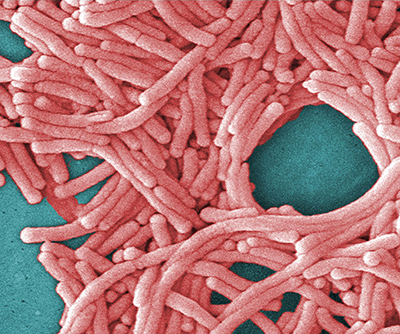
Scanning electron micrograph depicting a large grouping of Legionella pneumophila bacteria.
Credit: CDC/Margaret Williams, Ph.D.; Claressa Lucas, Ph.D.; Tatiana Travis, B.S.
Identifying factors responsible for the virulence of disease-causing bacteria is often complicated by the existence of multiple genes that perform similar functions. These redundancies generally benefit the microbe, but they serve as obstacles for scientists seeking to understand biological processes. Experimental methods to disrupt a single gene may not produce detectable effects, hindering further analyses.
- To assess how combinations of genes contribute to a biological outcome, the Machner Lab developed a technique to simultaneously disrupt multiple genes. They applied their approach, called multiplex, randomized CRISPR interference sequencing (MuRCiS), to assess a group of 44 genes that contribute to the virulence of Legionella pneumophila, the bacterium that causes Legionnaires’ disease.
- Using MuRCiS, the scientists identified several combinations of genes critical for the bacterium’s virulence. For example, they found that the genes lpg2888 and lpg3000had redundant functions during L. pneumophila infection of human macrophages, while lpg3000 alone was essential for L. pneumophila virulence in amoebas, which serve as a living host in which the pathogen can survive long-term and reproduce.
- The results illustrate how MuRCiS can serve as a method to rapidly examine redundant genes, setting the stage for application of the technology to other biological contexts and organisms.
NICHD authors of the paper include Nicole A. Ellis, Jessica Tung, Anne Davidson Ward, Kathryn Johnston, Katherine E. Bonnington, and Matthias P. Machner.
Learn more about the Cell and Structural Biology group: https://www.nichd.nih.gov/about/org/dir/affinity-groups/CSB
 BACK TO TOP
BACK TO TOP